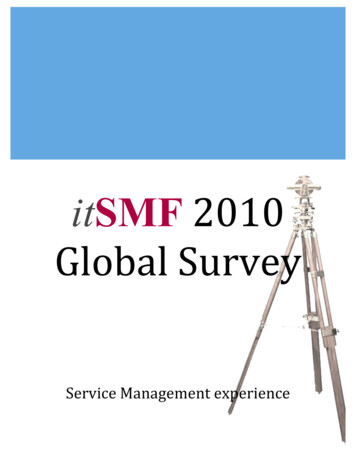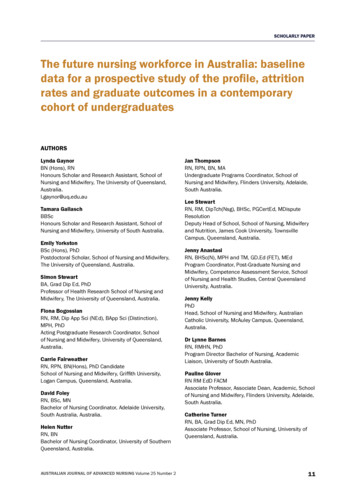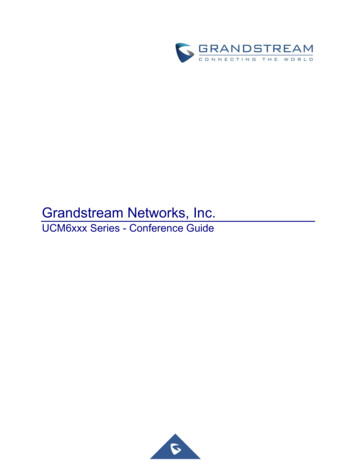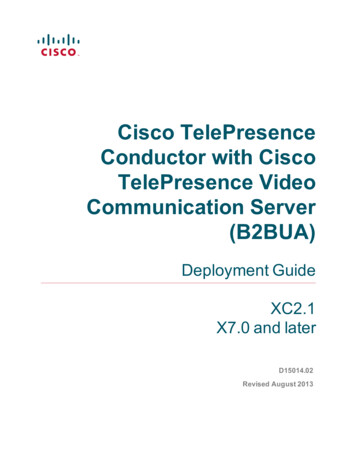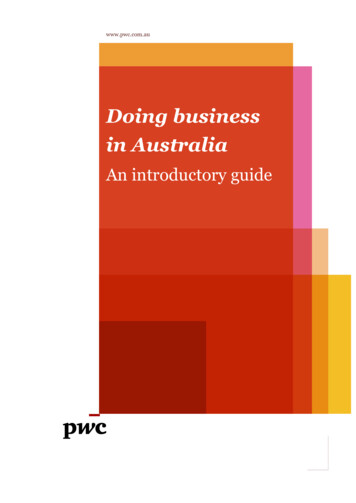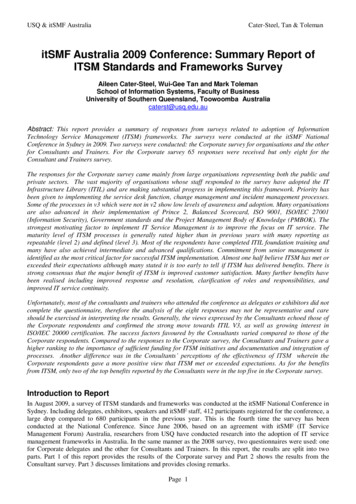
Transcription
USQ & itSMF AustraliaCater-Steel, Tan & TolemanitSMF Australia 2009 Conference: Summary Report ofITSM Standards and Frameworks SurveyAileen Cater-Steel, Wui-Gee Tan and Mark TolemanSchool of Information Systems, Faculty of BusinessUniversity of Southern Queensland, Toowoomba Australiacaterst@usq.edu.auAbstract: This report provides a summary of responses from surveys related to adoption of InformationTechnology Service Management (ITSM) frameworks. The surveys were conducted at the itSMF NationalConference in Sydney in 2009. Two surveys were conducted: the Corporate survey for organisations and the otherfor Consultants and Trainers. For the Corporate survey 65 responses were received but only eight for theConsultant and Trainers survey.The responses for the Corporate survey came mainly from large organisations representing both the public andprivate sectors. The vast majority of organisations whose staff responded to the survey have adopted the ITInfrastructure Library (ITIL) and are making substantial progress in implementing this framework. Priority hasbeen given to implementing the service desk function, change management and incident management processes.Some of the processes in v3 which were not in v2 show low levels of awareness and adoption. Many organisationsare also advanced in their implementation of Prince 2, Balanced Scorecard, ISO 9001, ISO/IEC 27001(Information Security), Government standards and the Project Management Body of Knowledge (PMBOK). Thestrongest motivating factor to implement IT Service Management is to improve the focus on IT service. Thematurity level of ITSM processes is generally rated higher than in previous years with many reporting asrepeatable (level 2) and defined (level 3). Most of the respondents have completed ITIL foundation training andmany have also achieved intermediate and advanced qualifications. Commitment from senior management isidentified as the most critical factor for successful ITSM implementation. Almost one half believe ITSM has met orexceeded their expectations although many stated it is too early to tell if ITSM has delivered benefits. There isstrong consensus that the major benefit of ITSM is improved customer satisfaction. Many further benefits havebeen realised including improved response and resolution, clarification of roles and responsibilities, andimproved IT service continuity.Unfortunately, most of the consultants and trainers who attended the conference as delegates or exhibitors did notcomplete the questionnaire, therefore the analysis of the eight responses may not be representative and careshould be exercised in interpreting the results. Generally, the views expressed by the Consultants echoed those ofthe Corporate respondents and confirmed the strong move towards ITIL V3, as well as growing interest inISO/IEC 20000 certification. The success factors favoured by the Consultants varied compared to those of theCorporate respondents. Compared to the responses to the Corporate survey, the Consultants and Trainers gave ahigher ranking to the importance of sufficient funding for ITSM initiatives and documentation and integration ofprocesses. Another difference was in the Consultants’ perceptions of the effectiveness of ITSM wherein theCorporate respondents gave a more positive view that ITSM met or exceeded expectations. As for the benefitsfrom ITSM, only two of the top benefits reported by the Consultants were in the top five in the Corporate survey.Introduction to ReportIn August 2009, a survey of ITSM standards and frameworks was conducted at the itSMF National Conference inSydney. Including delegates, exhibitors, speakers and itSMF staff, 412 participants registered for the conference, alarge drop compared to 680 participants in the previous year. This is the fourth time the survey has beenconducted at the National Conference. Since June 2006, based on an agreement with itSMF (IT ServiceManagement Forum) Australia, researchers from USQ have conducted research into the adoption of IT servicemanagement frameworks in Australia. In the same manner as the 2008 survey, two questionnaires were used: onefor Corporate delegates and the other for Consultants and Trainers. In this report, the results are split into twoparts. Part 1 of this report provides the results of the Corporate survey and Part 2 shows the results from theConsultant survey. Part 3 discusses limitations and provides closing remarks.Page 1
USQ & itSMF AustraliaCater-Steel, Tan & TolemanPart 1 – Corporate Survey Results1.1 Introduction to Corporate SurveyThe questionnaire used in the Corporate survey comprised five sections as shown in Table 1.1.Table 1.1: Composition of corporate survey questionnaireSectionABCDEFTopicOrganisational demographicsCurrent initiatives and progressITSM initiative, progress and green ITPerceptions of factors contributing to successPerceptions of ITSM effectivenessTraining and itSMF membershipNumber of questions715123As delegates exited from the Keynote presentations, they were provided with a copy of the Corporatequestionnaire and requested to complete it at the conference. In total, 65 completed questionnaires were returned.These were scanned by itSMF staff using an optical mark recognition (OMR) system. The resulting Excel filewas checked against the survey forms, corrected and used to perform statistical analysis. Where respondents wroteresponses in the ‘other’ category, these responses were examined and where possible recoded into existingcategories. The survey responses were anonymous, but respondents were invited to record their name, addressand email address if they wished to go into the prize draw and/or receive a summary report of the results of thesurvey. In this report, the responses to the survey are compiled in a series of tables and figures. Important findingsare highlighted. In future research, these results will be compared with the results from the surveys from previousconferences (2005 Brisbane, 2006 Sydney, 2007 Melbourne, 2008 Canberra) to identify progress and trends.1.2 Respondent Profile – Survey Section AThere were many different position titles selected and recorded by respondents. To reduce the variety forreporting purposes, all responses naming management of individual processes (e.g. service level, incident,capacity etc.) were summarised as ‘Process Manager’. As shown in Figure 1.1, this was the most frequentlyreported position (28%), followed by IT Service/Support Manager (8%), CIO/IT Manager (6%) and service deskmanager (4%), and operations managers (4%). There were a large number ‘other’ positions, most were recodedinto existing categories. The remaining eight ‘other’ positions were General Manager, service design & transitionteam leader, solutions architect, knowledge manager, business improvement & process management, IToperations analyst, state and govt director, and business analyst.Figure 1.1: Distribution of respondent position in organisationPage 2
USQ & itSMF AustraliaCater-Steel, Tan & TolemanAs shown in Figure 1.2, large contingents of respondents were from the Victoria (26%) and Australian CapitalTerritory (23%). Also well represented were Queensland (15%). New South Wales (14%), Western Australia(11%), and Tasmania (8%). It is surprising that NSW did not represent the largest cohort: in previous years thehost state accounted for the largest proportion of respondents: 2008 Canberra ACT 21%; 2007 MelbourneVictoria 37%; 2006 Sydney NSW 24%; 2005 Brisbane QLD 27%.Figure 1.2: Distribution of responses by stateAs shown in Figure 1.3, the Government Admin and Defence sector was strongly represented accounting for 43percent. The Education sector (17%) and Property and Business Services (includes IT firms) (15%) sector werealso well represented. Other sectors with smaller cohorts were Finance and Insurance (8%), Manufacturing,Construction & Mining, (8%), Hospitality & Tourism (3%), and Healthcare (3%). Other sectors recorded wereScience and Technology, and Utilities.Figure 1.3: Distribution by industry sectorWhen asked about the ownership of the organisation, as shown in Figure 1.4, the large majority (77%) ofrespondents worked for wholly national owned organisations, not surprising considering the high proportion ofresponses from the education and government sectors.Page 3
USQ & itSMF AustraliaCater-Steel, Tan & TolemanFigure 1.4: Distribution by organisation ownershipMost of the organisations were large with more than one half reporting an annual budget/turnover in excess of 150 million, and 70.7 percent represented organisations with more than 2,000 staff, as shown in Table 1.2. Therewas wide variation in the size of the IT departments with almost nine percent of respondents reporting less than 20IT staff, while 38 percent represented organisations with large IT departments of more than 400 staff.Table 1.2: Summary of organisation budget, total number of employees and number of IT staffFrequencyPercentAnnual turnover/budget46.2% 10M23.1% 10m - 49m46.2% 50m - 149m710.7% 150m - 500m2843.1% 500m1929.2%Don't Know11.5%Blank65100.0%TotalTotal number of employees (Full Time)23.1% 9991624.6%2,000-,49991320%5,000-9,9991726.1% 10,00065100.0%TotalNumber of IT professionals (Full Time)34.6% 201421.5%20-99710.8%100-1991624.6%200-3992538.5% 40000.0%Blank65100.0%TotalPage 4
USQ & itSMF AustraliaCater-Steel, Tan & Toleman1.3 Service Management and Related Frameworks – Survey Section BWhen asked about current initiatives related to service management, governance and quality management,considering the focus of the itSMF conference, it was not surprising that the most popular initiative was the ITInfrastructure Library (ITIL) with only one respondent reporting that they had no plans to implement ITIL. Theothers had either started (9% of respondents), partially (30%), largely (51%) or fully (8%) implemented the ITILframework.In order to compare the relative implementation of various frameworks, a five-point Likert scale was used to codethe responses: no plans to implement initiative - 0; starting to implement the initiative - 1; the initiative is partiallyimplemented: 2; the initiative is largely implemented- 3; the initiative is fully implemented - 4. ‘Don’t know’ andblank responses were excluded from the calculation of the average status. As shown in Table 1.3, recent strongadoption was reported for the Prince 2 project management framework. Prince 2 and ITIL are stable mates bothoriginating from the OGC. More than half of the respondents who answered this question are in the process ofimplementing the Prince 2 framework, and five respondents reported that such a framework was fullyimplemented. Many organisations are in the mature adoption stage of implementing Balanced Scorecard, ISO9001, ISO/IEC 27001 (Information Security), Government standards and the Project Management Body ofKnowledge (PMBOK).Table 1.3: Implementation of ITSM and other frameworksStatus of ImplementationITSM and other frameworksNNo plans0Starting1Partially2Largely3ITILISO/IEC 20000 ITSM6565HP ITSMMicrosoft MOFIBM SMSLInternallydevelopedframework65656565IT Service Management Frameworks162033259104Proprietary 656565Other IEC 38500ISO 9001ISO/IEC 15504ISO/IEC 19770ISO/IEC 27001/AS7799SEI CMMIBalance ScorecardPrince 2PMBOKSix SigmaFederal/State Govt IT 0.391.350.671.511.831.210.631.241.001.4 ITSM Initiatives and Progress – Survey Section CThe question exploring the organisation’s motivation to adopt ITSM allowed for multiple responses. As shown inTable 1.4, the desire to improve the IT service focus was overwhelming in its motivation, selected by 49 of the 65respondents (75%), followed by IT/business process integration (46%), cost reduction (22%), internal compliance(18%), and external compliance (17%). Other sources of motivation reported were to improve the ability to workwith third parties, and to consult in ITSM.Page 5
USQ & itSMF AustraliaCater-Steel, Tan & TolemanTable 1.4: Motivation to adopt ITSMMotivation FactorTo improve IT/business process integrationTo improve IT service focusTo reduce costsInternal compliance (management or business)External compliance(government or client)OtherDon’t 4%16.9%4.6%0%In considering the results of this survey, the role of the respondent in the ITSM implementation may have somebearing, especially when it comes to evaluating perceptions of success factors and satisfaction. More than onethird of respondents reported that their role was that of process owner (32%). A substantial number of respondentswere sponsors (9%), process team members (18%), consultants (17%) and project managers (6%). Respondentsalso recorded other roles: Architect; Leader; and ‘Victim’!To compare adoption progress of specific ITIL processes, the implementation progress of the processes wasranked using a six-point Likert scale to recode the responses to a numerical value: no plans to implement process 0; not yet started to implement the process - 1; in early stage of implementation of process - 2; half-way stage ofimplementation - 3; advanced stage of implementation – 4; and completed implementation - 5. ‘Don’t know’ andblank responses were excluded from the calculation of the average progress stage.In previous years, ITIL v2 processes were listed. ITIL Version 3, the latest version was released in May 2007. Asmost respondents indicated last year that they were upgrading to ITIL v3 the ITIL implementation questions werechanged to reflect v3 processes. The implementation progress is reported in Tables 1.5-1.9 reflecting the structureof the five ITIL v3 books.The service operation processes and functions (Table 1.8) are most advanced in implementation, followed by theservice transition group of processes (Table 1.7). The service desk function is the most fully implemented,followed by change management and incident management processes. Some of the processes in v3 which werenot in v2 show low levels of awareness and adoption, for example, evaluation, supplier management, the 7-stepimprovement process, and service management.Table 1.5: Extent of implementation of ITIL service strategy processesProgress of ImplementationITIL V3 componentsService portfolio managementDemand managementFinancial managementNoplans0Notstarted1Earlystage2Half Table 1.6: Extent of implementation of ITIL service design processesProgress of ImplementationITIL V3 componentsService catalogue managementService Level ManagementSupplier ManagementCapacity ManagementAvailability ManagementIT Service Continuity ManagementInformation Security ManagementNoplans0Notstarted1Earlystage2Half way3110221298152017810232121182121161411746123Page 142.132.662.85
USQ & itSMF AustraliaCater-Steel, Tan & TolemanTable 1.7: Extent of implementation of ITIL service transition processesProgress of ImplementationITIL V3 componentsChange ManagementService Asset & ConfigurationManagementService Knowledge ManagementTransition Planning and SupportReleaseandDevelopmentManagementService Testing and eStatusNoplans0Notstarted1Earlystage2Half 51.90Don'tknowBlankTable 1.8: Extent of implementation of ITIL service operation processes and functionsProgress of ImplementationITIL V3 componentsIncident ManagementProblem ManagementRequest FulfilmentAccess ManagementEvent ManagementFunction: Service DeskFunction:ITOperationsManagementFunction: Technical ManagementFunction: Applications lans0Notstarted1Earlystage2Half lankTable 1.9: Extent of implementation of ITIL service design processesProgress of ImplementationITIL V3 componentsThe 7 – Step Improvement ProcessService MeasurementService ReportingNoplans0Notstarted1Earlystage2Half spondents were asked to estimate the overall current level of maturity of their organisation’s ITSM processes.Maturity levels were provided as follows:Level 1 Initialprocesses are ad hoc and disorganisedLevel 2 Repeatable processes follow a regular patternLevel 3 Definedprocesses are documented and communicatedLevel 4 Managedprocesses are monitored and measuredLevel 5 Optimisedprocesses are followed and automated.As shown in Figure 1.5, the largest proportion reported was for level 2 (repeatable) with almost one third ofresponses for level 3 (defined).Page 7
USQ & itSMF AustraliaCater-Steel, Tan & TolemanFigure 1.5: Distribution by maturity levelFor the first time, the questionnaire included a section on Green IT initiatives. As shown in Table 1.10,respondents reported a large variation regarding efforts towards implementation of IT Green activities. Although ahandful of organisations had fully implemented most of the initiatives listed, at the other extreme a largerproportion did not know if their organisation was undertaking these Green IT actions.The initiative exhibiting the most mature level of implementation related to waste disposal with 93 percent ofrespondents indicating a policy was at some stage of implementation to dispose of IT wastes in the mostenvironmentally friendly way possible. Two thirds of respondents reported that their organisation had a Green ITpolicy but it was fully implemented in only two organisations. The question relating to the ability of theconfiguration management database (CMDB) and configuration management system (CMS) to drive green goalsdrew a positive response from 66 percent of respondents. Power consumption analysis of IT equipment is on theagenda for more than half the respondents.Table 1.10: Extent of implementation of Green IT initiativesProgress of implementationGreen IT InitiativesDoes your organisation have a Green-IT policy?Have you included Green IT goals in the definedservice levels?Do you have a process for analysing powerconsumption of IT equipment?Do you track cost-savings associated with Greentactics and strategies?Do you ensure that your suppliers meet Greencriteria and their products support the business’sGreen objectives?Does your CMDB/CMS store information that helpsdrive Green goals?Do you have a policy to dispose of IT wastes in themost environmentally friendly way possible?Is your organisation shifting towards virtualisationto reduce the number of 211173180.661622285302.063101020402.48Two comments were recorded for other green IT initiatives: no business cards for most staff; have a policy fordestruction in most effective way (not efficient).Page 8
USQ & itSMF AustraliaCater-Steel, Tan & Toleman1.5 Perceptions Related to Success Factors – Survey Section DTo gauge their perceptions about the importance of success factors of ITIL implementation, the respondents wererequested to indicate the importance of 10 factors on a scale from 1 (high importance) to 5 (low). In order toevaluate perceptions relating to success factors, a five-point Likert scale was used to weight the responses bycoding the responses from five for the most important factor to one for the lowest in importance. From a total listof 10 factors, the top five are shown in Table 1.11 with the complete list included in the appendix (Table A1.1). Itis widely recognised that management commitment and support is essential for any major process improvementinitiative. Top management can take a leadership role and adopt a longer-range perspective of the benefits thusensuring sufficient allocation of resources and overcoming organisational resistance. Consistent with this view, byfar the most important factor identified by the respondents was the commitment of senior management.Understanding of business needs was recognised as the second most important factor and effective changemanagement for user/customer was also highly favoured. ITSM training for IT staff received the fourth highestweighted score. Involvement of business staff came in fifth position of importance.In addition to the factors provided, respondents recorded additional success factors: assign accountability;understanding/alignment with business strategy; ability to demonstrate value; client/contractual requirements; andculture.Table 1.11: Importance of Success factors by weighted scoreImportance of success factorsSuccess factorsCommitment from senior managementUnderstanding of business needsEffective change management for user/customerITSM training provided for IT staffInvolvement of business w00000WeightedScore2862682652632621.6 ITSM Effectiveness and Benefits – Survey Section EIn regards to perceptions held by respondents regarding the effectiveness of ITSM, a large group of respondentsfelt that it was too early to tell if their expectations were met (33%). As the respondents were attending the itSMFconference, it was not surprising that many reported a positive response when asked about their perceptionsregarding the effectiveness of ITSM. As shown in Figure 1.6, eight percent of respondents reported that ITIL hadexceeded their expectations, and a further 41 percent felt that ITSM had met their expectations. However, therewas some dissent – five percent were disappointed with the effectiveness of ITSM.Page 9
USQ & itSMF AustraliaCater-Steel, Tan & TolemanFigure 1.6: Perceptions of satisfaction with ITSMRespondents were asked to consider nine statements related to benefits of ITSM and then record on a scale of 1(highly) to 5 (low) the significance of the benefits to their organisation. Using the same coding for benefits aspreviously applied to the success factors, a five-point Likert scale was used to weight the responses from five forthe highest significance to one for the least significant. From the total list of nine benefits, the most significant sixbenefits are shown in Table 1.12 with the complete list included in the appendix (Table A1.2).The most significant benefit selected by the respondents was that ITSM provides improved customer satisfaction,followed by improved response and resolution. Equally scored were clear identification of roles andresponsibilities, and improved IT service continuity. The fourth benefit is that IT services are coordinated,followed by better IT resources use in fifth position. The five selected benefits and rank order are the same asthose selected by respondents in the 2007 and 2008 survey. Respondents suggested another benefits as beingimportant: improved system design.Table 1.12: Perceived benefits of ITSMPerceived benefitsImproved customer satisfactionImproved response & resolutionRoles/responsibilities clearImproved IT service continuityReduced cost/incidentImproved IT employee productivity1 High1691110106Relative significance of core5 Low01201002192122012012002001.7 Training and itSMF Membership – Survey Section FThe survey enquired about the extent of ITSM training and certification undertaken by each respondent. As shownin Table 1.13, most of the respondents (89%) had achieved a Foundation certificate. At the intermediate level,almost one quarter had completed a Professional certificate (25%), and more than that proportion had achieved theITIL advanced/manager certificate (28%). A small number of respondents reported achieving certificates for nonITIL training such as ISO/IEC 20000, and Prince2.Page 10
USQ & itSMF AustraliaCater-Steel, Tan & TolemanTable 1.13: Training and examinationsTraining QualificationFrequencyPercentFoundationAchieved Foundation Certificate– YesNot achieved Foundation CertificateFoundation Certificate Framework – ITILFoundation Certificate Framework - ISO/IEC 20000OtherBlankIntermediateIntermediate / Professional Certificate – YesIntermediate / Professional Certificate – NoIntermediate / Professional Certificate Framework - ITILIntermediate / Professional Certificate Framework - ISO/IEC 20000Other– Prince2, HDI/HDAA, Change ManagementBlankAdvancedAdvanced/Manager Certificate – YesAdvanced/Manager Certificate – NoAdvanced/Manager Certificate Framework – ITILAdvanced/Manager Certificate Framework – ISO/IEC 20000Advanced/Manager Certificate Framework – AIPM 1839161128%60%25%5%5%Most of the respondents (88%) are members of itSMF. Corporate membership is popular and held by 68 percentof respondents and 11 respondents hold individual membership.1.8 Other Comments – Survey Section GTwo respondents commented that they represented ITSM consultant firms and that the questionnaire was notappropriate for them. Unfortunately they were not aware that a separate questionnaire was provided to becompleted by consultants and trainers. Improved methods of distribution of forms and ways to promote awarenessof the survey will be considered by the research team to improve the survey for next year.1.9 Corporate Survey ConclusionsIn summary, the survey conducted at the 2009 itSMF National conference in Sydney produced similar results asprevious surveys (2005, 2006, 2007 and 2008). It was surprising that the number of responses from the conferencehost state (NSW) was less than the number from Victoria, ACT and Queensland. Many public sectororganisations and private sector firms have adopted ITSM and are making substantial progress in implementingthe ITIL framework. Large government organisations, especially those with a large IT workforce are leading theimplementation. The vast majority of people who responded to the survey have adopted the IT InfrastructureLibrary (ITIL) and are making substantial progress in implementing this framework. Priority has been given toimplementing the service desk function, change management and incident management processes. Some of theprocesses in v3 which were not in v2 show low levels of awareness and adoption. Many organisations are alsoadvanced in their implementation of Prince 2, Balanced Scorecard, ISO 9001, ISO/IEC 27001 (InformationSecurity), Government standards and the Project Management Body of Knowledge (PMBOK).The strongest motivating factor to implement IT Service Management is to improve the focus on IT service. Thisrepresents a shift in focus as the 2008 survey reported improving IT/business process integration as the primemotivator. The maturity level of ITSM processes was generally rated higher than in previous years with manyreporting as repeatable (level 2) and defined (level 3). Most of the respondents had completed ITIL foundationtraining and many have also achieved intermediate and advanced qualifications. It is not surprising thatcommitment from senior management is identified as the most critical factor for successful ITSM implementation,followed by understanding the business needs. Although many stated it is too early to tell if ITSM has deliveredbenefits, almost one half believe it has met or exceeded their expectations, an increase from last year’s survey.There was strong consensus that the major benefit of ITSM is improved customer satisfaction. Many furtherPage 11
USQ & itSMF AustraliaCater-Steel, Tan & Tolemanbenefits have been realised including improved response and resolution, clarification of roles and responsibilities,and improved IT service continuity.Part 2 Consultants and Trainers Survey Results2.1 Introduction to Consultants and Trainers SurveyConference delegates from USQ distributed the questionnaire to exhibitor staff at the stands in the exhibition hallof the conference and requested they complete it at the conference. There were 81 exhibitors registered at theconference. The questionnaire used to survey the Consultants and Trainers was comprised of five sections asshown in Table 2.1Table 2.1: Composition of consultant/trainer survey questionnaireSectionABCDETopicNumber of questionsOrganisational demographicsYour clients’ ITSM initiatives and progressPerceptions of factors contributing to successPerceptions of ITSM effectivenessitSMF membership3411115In total, only eight completed questionnaires were returned. This was very disappointing, especially as twoconsultants who answered the Corporate questionnaire commented that the questions were not suitable forconsultants and trainers. The completed questionnaires were scanned by itSMF staff using an optical markrecognition (OMR) system. The resulting Excel file was checked against the survey forms and used to performstatistical analysis. The survey responses were anonymous, but respondents were invited to record their name,address and email address if they wished to receive a summary of the results of the survey.2.2 Respondent Profile – Survey Section AThe respondents to the consultants’ survey were from New South Wales (2), Victoria (4), Queensland (1),Western Australia (1). Although many of the respondents reported that their firm serviced clients from a widerange of sectors, two respondents represented firms which specifically focussed on the Education sector, andselected Property and business services, as shown in Table 2.2.Table 2.2: Industry sector of clientsIndustry SectorProperty & bus
Abstract: This report provides a summary of responses from surveys related to adoption of Information Technology Service Management (ITSM) frameworks. The surveys were conducted at the itSMF National Conference in Sydney in 2009. . reporting purposes, all responses naming management of individual processes (e.g. service level, incident .
